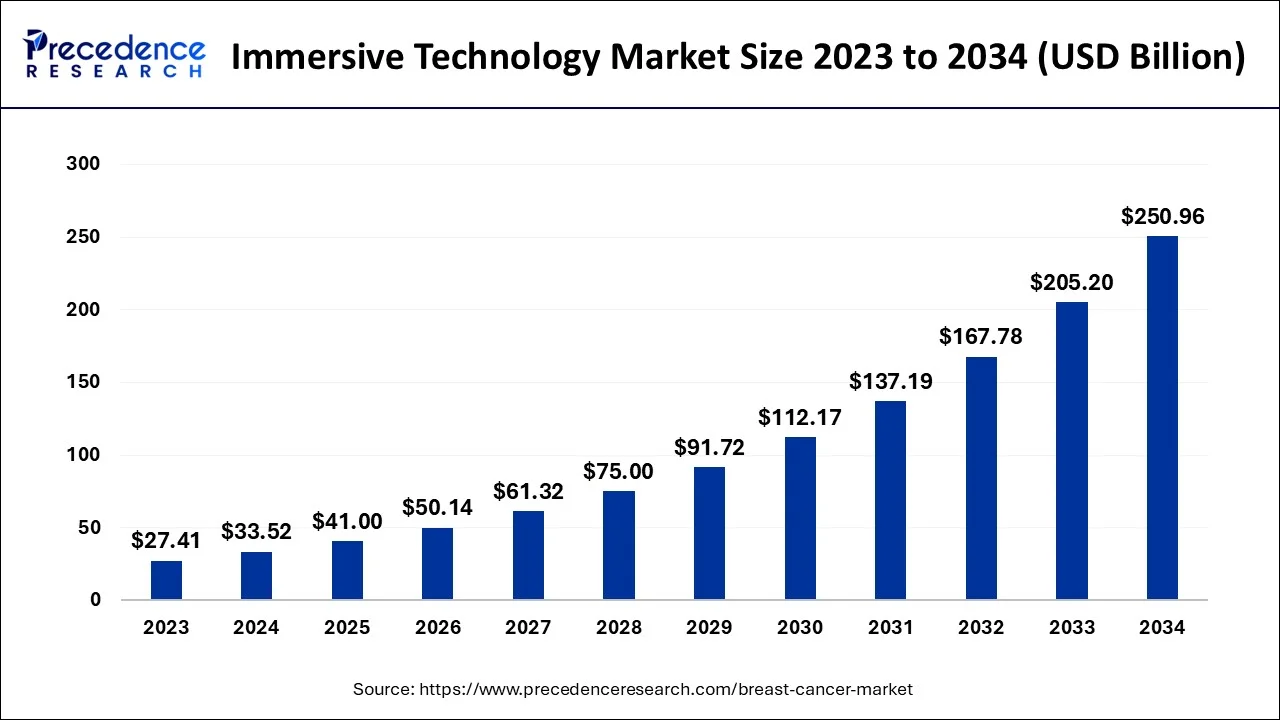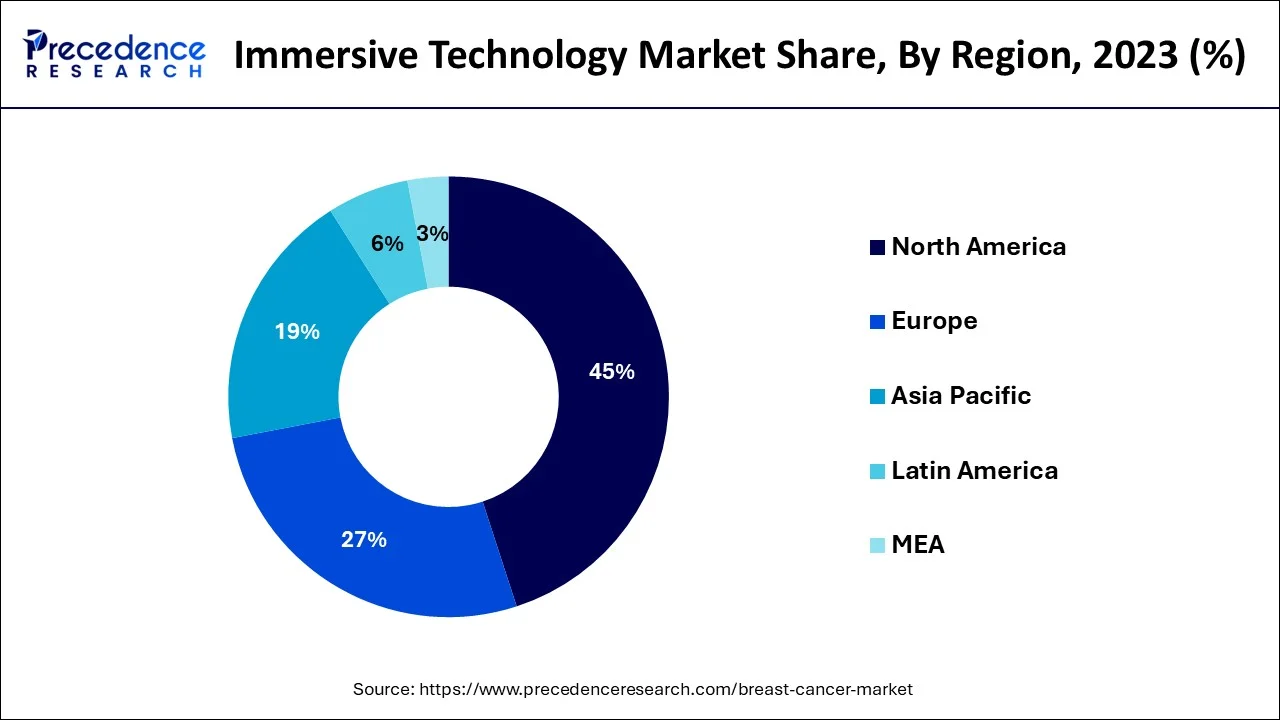February 2025
The global immersive technology market size accounted for USD 33.52 billion in 2024, grew to USD 41 billion in 2025 and is predicted to surpass around USD 250.96 billion by 2034, representing a healthy CAGR of 22.30% between 2024 and 2034. The North America immersive technology market size is calculated at USD 15.08 billion in 2024 and is expected to grow at a fastest CAGR of 22.43% during the forecast year.
The global immersive technology market size is estimated at USD 33.52 billion in 2024 and is anticipated to reach around USD 250.96 billion by 2034, expanding at a CAGR of 22.30% from 2024 to 2034.

The U.S. immersive technology market size is evaluated at USD 10.56 billion in 2024 and is predicted to be worth around USD 80.50 billion by 2034, rising at a CAGR of 22.51% from 2024 to 2034.

In 2023, North America had the greatest revenue share and the biggest interactive technology market of revenue, and the biggest market for interactive technology. The country's growing technological advancements and changing consumer preferences are mostly responsible for the North American industry's revenue and profit. The desire for head-mounted screens is also being fueled by their rising reputation and limited supply in the country's wealthy nations. Due to the existence of top industry companies in the region, such as Unity Development Corporation, Zeality Corporation, Lockheed Martin, Wizard Jumping, HCL Technologies, Google, Constrained, and Honeywell Worldwide, Inc., the interactive virtual innovation industry in the United States is anticipated to experience strong revenue expansion throughout of the forecast timeframe.

And over the forecast timeframe, the industry for augmented reality technology in Asia-Pacific is anticipated to develop at the quickest CAGR. APAC growing demand is primarily driven by reasons such as rising smartphone ownership, growing disposable income, growing regional nation-state expansion, and unexplored markets for top firms in the sector. Immersion technology is being more widely used for teaching and commerce, which is boosting the APAC industry's expansion.
Improved networking protocols and the growing acceptance of multimedia tools are major market revenue-generating aspects. Other significant variables that are anticipated to influence demand for interactive technology and promote market sales increase include the capacity to get experience in such a safe setting, improved gaming experiences, as well as the capability to evaluate theoretical concepts graphically.
The immersive technique combines digital and real-world elements in a way that enables users to interact in a virtual environment naturally. In an immersive environment, the user may come to accept artificial parts of the environment as a piece of the total and lose awareness that they are present. Virtual worlds are both hardware and software products that give users the ability to modify and replace real-world environments to get more information than they can from them. And along the virtual world spectrum, which extends from a purely physical world at one extreme to a fully virtual reality experience at the other, immersion technology is available in various places.
Government-sponsored programs that provide technical and financial assistance, education, and development are predicted to be a financially successful potential for the international economy of interactive technology. The immersion technique combines the actual world with digital or virtual realities. Users can experience the digital space in computer-augmented realities in great detail thanks to immersive technologies. The user of immersion technologies experiences a sense of immersion in the artificial world.
The virtual world refers to augmented worlds and virtual reality which substitutes for the person's surrounding world. The marketplace for interactive technology is developing quickly, with participants using a variety of tactics to draw customers, solidify their positions, and keep up with industry developments. To improve customer experience, industry companies are applying immersion technology in a variety of contexts, including e-commerce, interactive web applications, immersion marketing, brand experiences, and specific geographical explorations.
| Report Coverage | Details |
| Market Size in 2024 | USD 33.52 Billion |
| Market Size by 2034 | USD 250.96 Billion |
| Growth Rate from 2024 to 2034 | CAGR of 22.30% |
| Base Year | 2023 |
| Forecast Period | 2024 to 2034 |
| Segments Covered | Component, Technology, Application, Industry and Geography |
AR is utilized for charting and communicating on the battlefield
The Better gameplay experience offered by virtual objects and slashing capabilities that are alluring to consumers are better crucial drivers of the sales growth of the worldwide immersion electronic industry. This leads to higher interest and engagement in gaming. Physicians in the healthcare sector are using augmented reality (AR) glasses to plan body wounds and access patients' patient data while performing surgery. Throughout courses, learners can perceive text and dynamic capabilities thanks to augmented reality (AR). Augmented reality is being used by businesses to engage with coworkers across offices, boost product development creativity, and teaching personnel. Augmented reality (VR) is also being used in advertising to give consumers a hands-free experience with products. The defense sector is likewise implementing immersive technology. AR is utilized for charting and communicating on the battlefields, whereas VR is employed to teach personnel in a simulated environment that replicates real-world situations. Therefore, expanding the use of interactive technology across a variety of sectors is anticipated to promote sales increase.
Technology development and rising digitalization
Technological development and digitalization have been primary forces behind the adoption of emerging technologies across sectors including retail, healthcare, and industry. The way people live, interact, transport, and study has evolved as a result of ongoing technology improvements. To obtain a competitive advantage competitive advantages, organizations and enterprises have been able to cut manufacturing expenses and save time thanks to technological improvements. For example, 3G & 4G have lowered the operational costs for smaller firms so they can reach their intended audiences. The demand for digitalization has also been fueled by the rising use of cellular telephones. The younger breed, known as generation connected, is responsible for the global shift to digital technology. The development of digitalization has also been aided by improved social connectivity.
New technologies are significantly influencing how the workplace is being shaped
Utilization HMDs in education
From 2024 to 2034, the head-mounted display equipment segment is anticipated to represent the majority of the market in terms of revenue, with a participation of over 60.7% in 2023. The economic incentive for Virtual reality headsets is being driven by their increasing significance in both consumer and business applications. The variety and adaptability of HMDs, including hybridized, attached, and conscience HMDs, are what is driving the company's development.
These tools are used to deliver instruction in a variety of fields, such as defense, aviation, construction, academia, and medical, and they employ interactive images to show a broad range of scenarios. Organizations are always pursuing technological advancements in this area to order to give clients a more interactive experience. For example, the cutting-edge Rift S VR headset from Oculus, a division of Facebook Companies, LLC, was released in March 2019. It has internal navigation as well as a higher-resolution display than just its predecessors.
The category with gesture-tracking devices is anticipated to experience the highest CAGR throughout the projected timeframe, at 17.6%. The need for optical gesture control, a unique and quickly developing technology that enables more comprehensive and realistic interpersonal contact, has significantly increased, which can be related to the increase in the need for optical movement monitoring. Sensors, CPUs, VR projectors, big-screen screens, and several applications are a few examples of the various kinds of GTD VR hardware. Additionally, several businesses are working that improve the performance of the computers and sensors used in VR devices to give users a more interactive experience.
Over the projection timeframe, the interactive virtual category is anticipated to contribute the biggest income share. By superimposing a computer overlay on the physical surroundings, the augment system produces the blending of real-world and virtual elements to enhance the world today. This enables greater production, fewer accidents, and better performance. Electronic modeling and planning are possible with wearable technology before implementation. Additionally, it makes model validation in the actual world simpler and enables employees to re-evaluate and confirm in real-time. Those are a few of the main variables propelling this market's expansion.
Over the projected period, the entertainment sector is expected to outperform various sectors regarding regard to revenue share. Augmented and virtual realities are causing disruptions in the game industry. While VR offers a full recreation of the person's surroundings, AR integrates game images and sound into the surrounding world. It is anticipated that AR and VR will both boost business profitability and enhance the player experience. To enhance user experience and revenue, plenty of well game development companies are embracing AR and VR technology. Game developers will be able to create high-density, elevated online games thanks to 5G networks.
By Component
By Technology
By Application
By Industry
By Geography
For inquiries regarding discounts, bulk purchases, or customization requests, please contact us at sales@precedenceresearch.com
No cookie-cutter, only authentic analysis – take the 1st step to become a Precedence Research client
February 2025
February 2025
January 2025
October 2023